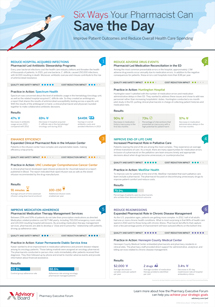Auto logout in seconds.
Continue LogoutRead Advisory Board's take: 2 reasons providers are turning to pharmacists
As the United States looks to curb the growing physician shortage, we're missing one solution "right in front of our eyes": Greater and improved involvement from pharmacists, Sachin Jain, CEO of CareMore HealthSystem, writes for Forbes.
How pharmacists can improve care
Pharmacists are "uniquely helpful," Jain writes. In addition to spending years learning about medications, many pharmacists, according to Jain, "have completed specialized residencies" in different areas of medicine. He explains, "That training informs evidence-based practices and ensures that the medications we prescribe are appropriate for each patient—while also reducing what we call 'treatment burdens,' which often prevent patients from taking their medications."
Jain writes that he saw the benefits of pharmacists' knowledge and support first hand at Brigham and Women's, where pharmacists would get together with doctors, nurse practitioners, and medical assistants to review the cases of the day. "The pharmacists flag patients who might be non-adherent to prescribed medications, offer insights into how dosages could be adjusted and educate their colleagues about the latest medications and guidelines for specific medications," Jain writes.
Jain cites another example, recalling a patient, who he refers to as Camille, who was diabetic and she suffered from depression and neuropathy, which caused a pain in her foot. The pharmacist reviewing Camille's EHR noticed that Camille had been prescribed duloxetine for her neuropathy and escitalopram oxalate for her depression and warned that the combination of drugs could lead to seizures, a breakdown of her muscles, or worse.
That pharmacist recommended Camille take duloxetine only and specified a dosage of the drug that would treat both her neuropathy and depression. Three months later, Camille is only taking a single pill daily, and it's helped reduce the pain of her neuropathy and her depression, Jain writes.
Pharmacists aren't just helpful with prescriptions, Jain writes. Another pharmacist colleague of Jain's once noticed that many diabetic patients were not taking their insulin on a regular basis. After speaking with patients, the pharmacist discovered that cost of "analogue insulin" was the obstacle keeping patients from taking their insulin.
To solve this problem, the pharmacy team began transitioning the patients to "human insulin," an older form of insulin that's more affordable and delivered similar outcomes. "This is work that many would traditionally see as the domain of physicians and nurse practitioners—and it was managed expertly, arguably better, by pharmacists," Jain writes.
Pharmacists are the "secret weapon we already have," Jain writes. "By relying on them more and further integrating them our healthcare delivery models, we can provide better, more affordable and more effective care to everyone-and potentially alleviate the looming crisis in access to primary care" (Jain, Forbes, 10/10).
Advisory Board's take

Lindsay Conway, Managing Director, Pharmacy Executive Forum
Pharmacists are highly skilled clinicians who are uniquely positioned to improve patient care, but because they've traditionally been relegated to behind-the-scenes roles, their talents often go overlooked.
This is starting to change. As with the doctor in this article, providers are increasingly turning to pharmacists for help as a result of two simultaneous trends:
- First, providers are finding it progressively more difficult to keep up with the hundreds of new prescription medications the FDA approves each year.
- Second, as the number of comorbid patients grows—and more individuals take multiple prescription drugs—physicians report feeling ill-equipped to reconcile these patients' medications. This is because they are required not only to focus on staying abreast of the medications directly related to their specialty, but all medications for all of the comorbid conditions their patients might have.
“The barrier to this greater pharmacist involvement is often cost”
As a result, more organizations are trying new models of integrating pharmacists into their clinical teams, in particular, enlisting pharmacists to support chronic disease and polypharmacy patients across settings of care.
However, the barrier to this greater pharmacist involvement is often cost—most health plans do not reimburse for pharmacists' time. That said, as providers continue to take on more responsibility for total costs of care, they will likely find that increasing pharmacists' engagement will be critical to improving patient outcomes and reducing costs. Moreover, the comparatively low cost of pharmacists versus other possible interventions will likely make projects involving them more appealing.
We've spoken with many organizations around the country beginning to lead this push. To learn how five of these organizations embedded pharmacy models into their primary care, and the best practices they uncovered along the way, be sure to download our research report on Integrated Pharmacy Models in Primary Care.
Then, to discover 13 pharmacy-led tactics for improving safety, efficiency and outcomes, read our research report on High-Reliability Medication Reconciliation.
Don't miss out on the latest Advisory Board insights
Create your free account to access 1 resource, including the latest research and webinars.
Want access without creating an account?
You have 1 free members-only resource remaining this month.
1 free members-only resources remaining
1 free members-only resources remaining
You've reached your limit of free insights
Become a member to access all of Advisory Board's resources, events, and experts
Never miss out on the latest innovative health care content tailored to you.
Benefits include:
You've reached your limit of free insights
Become a member to access all of Advisory Board's resources, events, and experts
Never miss out on the latest innovative health care content tailored to you.
Benefits include:
This content is available through your Curated Research partnership with Advisory Board. Click on ‘view this resource’ to read the full piece
Email ask@advisory.com to learn more
Click on ‘Become a Member’ to learn about the benefits of a Full-Access partnership with Advisory Board
Never miss out on the latest innovative health care content tailored to you.
Benefits Include:
This is for members only. Learn more.
Click on ‘Become a Member’ to learn about the benefits of a Full-Access partnership with Advisory Board
Never miss out on the latest innovative health care content tailored to you.

